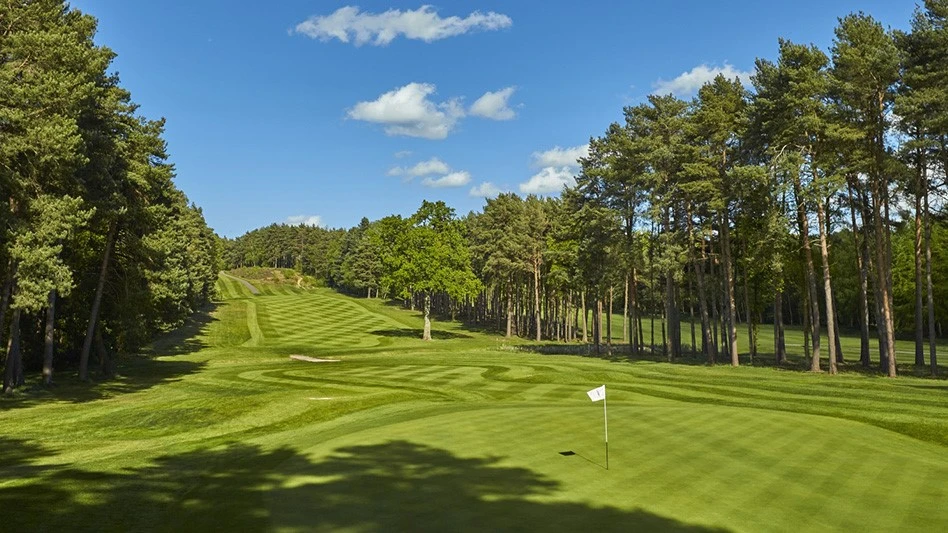
Courtesy of Foxhills (2)
Foxhills is a 45-hole, 400-acre resort and golf club in Surrey, in the southeast corner of England. How does the club operate? And what are they doing looking forward?
“We are in the final stages of a three- to five-year strategic improvement plan for the courses that will see a number of the flagship holes across both courses revitalised and elevated to a new and improved level,” said Chris Fitt, the club’s director of golf and leisure. “Looking to the future, we intend on improving the drainage across the site and providing our members and guests with better quality surfaces all year round, and especially during the wetter months.”
Fitt shared some of his approach and philosophy.
Golf has had a boom in recent years and this is likely to continue in the short term. In the United Kingdom, we are also experiencing an employment crisis and have a lack of candidates in greenkeeping coming through, so holding on to the existing team has never been more vital. It’s more important than ever to keep the team motivated, incentivized and create a great culture where the team love their job.
Foxhills has two fantastic, picturesque Surrey parkland courses. Golfers in Surrey are spoiled for choice, with many of the country’s — and even the world’s — top golf courses located here. Surrey is the Florida of the United Kingdom in that sense. Where most of the other venues only have 18 holes, we are fortunate enough to have 45 holes of golf to enjoy and our team do their best to make sure these are in the best possible condition all year round.
We are a business open for 365 days of the year, so there is always a demand for golf from a range of different golfers, be that members, visitors, corporates or hotel guests. Finding the downtime to carry out maintenance or rest the course is very challenging but we try to schedule at least two dedicated maintenance windows each year for the more demanding tasks such as hollow coring, scarifying and heavy topdressing.
Because of the clay-based soil we are built on, aeration and drainage practices are vital to us. We have consistently invested in this each year and have recently added in more resources to our operating budget for further aeration. We now work with leading agronomists to help advise on our agronomic program, improving efficiency, presentation and overall turf quality.
Technologically, we make use of a moisture meter to measure and monitor the moisture in our greens, how our agronomy practices are impacting these and identifying any potential issues or concerns. We also track every golfer using the system Tag Marshal, giving us real-time data on pace of play for every golfer, identifying high-traffic or problem areas where the courses regularly get held up. I’m sure there will be a number of innovations we introduce into day-to-day working practices in the coming years.
We have also swapped a number of our greenkeeping machines over to electric. Additionally, several wildflower gardens and bug hotels have been created to encourage natural wildlife development alongside beekeeping on the courses and estate. From a water perspective, we have a borehole and reservoir to which we limit our water consumption. We shut the irrigation system down in October to let nature take over, and then only reinstate it in March when the temperatures warm up and the courses demand it.
Golf in the UK can be very different than the U.S. Of course, we have the best links golf courses in the world with some of the most famous destinations — but also parkland, heathland and downland courses that have a picturesque character completely unique to the terrain and surroundings. Golf is also a sport that should be played in all kinds of weather, and in the UK, we can guarantee a broad spectrum of weather to enjoy golf in no matter what time of the year. That’s part of the fun!

Latest from Golf Course Industry
- From the publisher’s pen: Conscientious of a bigger role
- Bernhard and Company partners with Laguna Golf Phuket
- Terre Blanche showcases environmental stewardship
- VIDEO: Introducing our December issue
- Bernhard and Company introduces Soil Scout
- Nu-Pipe donates to GCSAA Foundation’s Centennial Campaign
- GCSAA enhances golf course BMP tool
- Melrose leadership programs sending 18 to 2026 GCSAA Conference and Trade Show





